RadarPDR: Radar-Assisted Indoor Pedestrian Dead Reckoning
Abstract
:1. Introduction
- Employ an FMCW ranging radar to assist inertial PDR for indoor pedestrian tracking;
- Correct distance measurement errors caused by concave/convex wall structure in actual indoor environments;
- Fuse corrected wall distance, pedestrian step length, and head direction for pedestrian trajectory adjustment.
2. Related Works
3. Problem Description
- When to enforce pedestrian pose adjustment?
- How to correct measurement for wall distance ?
- How to adjust a pedestrian pose based on ?
4. The Proposed RadarPDR Scheme
4.1. Overview
4.2. Wall Model Calibration
4.2.1. Operation Indicator Assignment
4.2.2. Wall Distance Correction
| Algorithm 1 Wall distance correction algorithm |
| Input: : wall distance observations Output: : wall distance corrections for each step do for each observation do 1. Get state estimations by standard Kalman filtering: , = KF () 2. Detect outlier and compute correction: if then , else , end if 3. Update trend: end for end for |
4.3. Multi-Source Information Fusion
4.3.1. Trajectory Adjustment
4.3.2. Wall Parameters Estimation
| Algorithm 2 Trajectory adjustment algorithm |
| Input: : step lengths, : heading increments, : wall distance, : indicators Output: : pose estimations 1: for each step do 2: if the indicator is operate then 3: for each particle do 4: Get its pose according to Equations (13)–(15) 5: Get its weight according to Equations (16)–(18) 6: end for 7: Perform Resampling 8: Get pose estimation by average of resampled particles 9: Update wall parameters according to Equations (21)–(29) 10: end if 11: if the indicator is suspend then 12: Get pose estimation by dead reckoning motion model 13: end if 14: if the indicator is reset then 15: Get pose estimation by dead reckoning motion model 16: Initialize wall parameters 17: end if 18: end for |
5. Experiments
5.1. Experiment Setup
- PurePDR: The traditional inertial pedestrian dead-reckoning, using the motion model to estimate pedestrian trajectory;
- RadarPDR w/o DC: The RadarPDR scheme without the wall distance correction (DC) module;
- RadarPDR w/o PU: The RadarPDR scheme without the wall parameter updating (PU) module.
5.2. Wall Distance Results
5.3. Wall Parameters’ Results
5.4. Trajectory Adjustment Results
6. Conclusions
Author Contributions
Funding
Institutional Review Board Statement
Informed Consent Statement
Data Availability Statement
Conflicts of Interest
References
- Davidson, P.; Piché, R. A survey of selected indoor positioning methods for smartphones. IEEE Commun. Surv. Tutor. 2016, 19, 1347–1370. [Google Scholar] [CrossRef]
- Basiri, A.; Lohan, E.S.; Moore, T.; Winstanley, A.; Peltola, P.; Hill, C.; Amirian, P.; e Silva, P.F. Indoor location based services challenges, requirements and usability of current solutions. Comput. Sci. Rev. 2017, 24, 1–12. [Google Scholar] [CrossRef] [Green Version]
- Díez, L.E.; Bahillo, A.; Otegui, J.; Otim, T. Step length estimation methods based on inertial sensors: A review. IEEE Sens. J. 2018, 18, 6908–6926. [Google Scholar] [CrossRef]
- Hou, X.; Bergmann, J. Pedestrian Dead Reckoning with Wearable Sensors: A Systematic Review. IEEE Sens. J. 2020, 21, 143–152. [Google Scholar] [CrossRef]
- Harle, R. A survey of indoor inertial positioning systems for pedestrians. IEEE Commun. Surv. Tutor. 2013, 15, 1281–1293. [Google Scholar] [CrossRef]
- Groves, P.D. Navigation using inertial sensors [Tutorial]. IEEE Aerosp. Electron. Syst. Mag. 2015, 30, 42–69. [Google Scholar] [CrossRef]
- Wu, Y.; Zhu, H.B.; Du, Q.X.; Tang, S.M. A survey of the research status of pedestrian dead reckoning systems based on inertial sensors. Int. J. Autom. Comput. 2019, 16, 65–83. [Google Scholar] [CrossRef]
- Foxlin, E. Pedestrian tracking with shoe-mounted inertial sensors. IEEE Comput. Graph. Appl. 2005, 25, 38–46. [Google Scholar] [CrossRef]
- Park, S.K.; Suh, Y.S. A zero velocity detection algorithm using inertial sensors for pedestrian navigation systems. Sensors 2010, 10, 9163–9178. [Google Scholar] [CrossRef] [Green Version]
- Zhang, W.; Li, X.; Wei, D.; Ji, X.; Yuan, H. A foot-mounted PDR system based on IMU/EKF+ HMM+ ZUPT+ ZARU+ HDR+ compass algorithm. In Proceedings of the 2017 International Conference on Indoor Positioning and Indoor Navigation (IPIN), Sapporo, Japan, 18–21 September 2017; pp. 1–5. [Google Scholar]
- Zhang, W.; Wei, D.; Yuan, H.; Yang, G. Cooperative positioning method of dual foot-mounted inertial pedestrian dead reckoning systems. IEEE Trans. Instrum. Meas. 2021, 70, 8502114. [Google Scholar] [CrossRef]
- Tong, X.; Su, Y.; Li, Z.; Si, C.; Han, G.; Ning, J.; Yang, F. A double-step unscented Kalman filter and HMM-based zero-velocity update for pedestrian dead reckoning using MEMS sensors. IEEE Trans. Ind. Electron. 2019, 67, 581–591. [Google Scholar] [CrossRef]
- Borenstein, J.; Ojeda, L.; Kwanmuang, S. Heuristic Reduction of Gyro Drift in IMU-based Personnel Tracking Systems. J. Navig. 2009, 62, 41–58. [Google Scholar] [CrossRef] [Green Version]
- Borenstein, J.; Ojeda, L. Heuristic drift elimination for personnel tracking systems. J. Navig. 2010, 63, 591. [Google Scholar] [CrossRef] [Green Version]
- Jiménez, A.R.; Seco, F.; Zampella, F.; Prieto, J.C.; Guevara, J. Improved Heuristic Drift Elimination (iHDE) for pedestrian navigation in complex buildings. In Proceedings of the 2011 International Conference on Indoor Positioning and Indoor Navigation, Guimaraes, Portugal, 21–23 September 2011; pp. 1–8. [Google Scholar]
- Ju, H.; Lee, M.S.; Park, C.G.; Lee, S.; Park, S. Advanced heuristic drift elimination for indoor pedestrian navigation. In Proceedings of the 2014 International Conference on Indoor Positioning and Indoor Navigation (IPIN), Busan, Republic of Korea, 27–30 October 2014; pp. 729–732. [Google Scholar]
- Ju, H.; Park, S.Y.; Park, C.G. A smartphone-based pedestrian dead reckoning system with multiple virtual tracking for indoor navigation. IEEE Sens. J. 2018, 18, 6756–6764. [Google Scholar] [CrossRef]
- Radu, V.; Marina, M.K. HiMLoc: Indoor smartphone localization via activity aware pedestrian dead reckoning with selective crowdsourced WiFi fingerprinting. In Proceedings of the International Conference on Indoor Positioning and Indoor Navigation, Montbeliard, France, 28–31 October 2013; pp. 1–10. [Google Scholar]
- Shi, L.F.; Wang, Y.; Liu, G.X.; Chen, S.; Zhao, Y.L.; Shi, Y.F. A Fusion Algorithm of Indoor Positioning Based on PDR and RSS Fingerprint. IEEE Sens. J. 2018, 18, 9691–9698. [Google Scholar] [CrossRef]
- Li, W.; Wang, B.; Yang, L.T.; Zhou, M. RMapTAFA: Radio map construction based on trajectory adjustment and fingerprint amendment. IEEE Access 2019, 7, 14488–14500. [Google Scholar] [CrossRef]
- Zou, H.; Chen, Z.; Jiang, H.; Xie, L.; Spanos, C. Accurate indoor localization and tracking using mobile phone inertial sensors, WiFi and iBeacon. In Proceedings of the 2017 IEEE International Symposium on Inertial Sensors and Systems (INERTIAL), Kauai, HI, USA, 27–30 March 2017; pp. 1–4. [Google Scholar]
- Tiwari, S.; kumar Jain, V. HILS: Hybrid indoor localisation system using Wi-Fi received signal strength and inertial sensor’s measurements of smart-phone. IET Commun. 2019, 13, 1595–1606. [Google Scholar] [CrossRef]
- Li, H.; Guo, H.; Qi, Y.; Deng, L.; Yu, M. Research on multi-sensor pedestrian dead reckoning method with UKF algorithm. Measurement 2021, 169, 108524. [Google Scholar] [CrossRef]
- Li, X.; Wang, J.; Liu, C. A Bluetooth/PDR integration algorithm for an indoor positioning system. Sensors 2015, 15, 24862–24885. [Google Scholar] [CrossRef] [Green Version]
- Yu, N.; Zhan, X.; Zhao, S.; Wu, Y.; Feng, R. A precise dead reckoning algorithm based on Bluetooth and multiple sensors. IEEE Internet Things J. 2017, 5, 336–351. [Google Scholar] [CrossRef]
- Chen, P.; Kuang, Y.; Chen, X. A UWB/improved PDR integration algorithm applied to dynamic indoor positioning for pedestrians. Sensors 2017, 17, 2065. [Google Scholar] [CrossRef] [PubMed] [Green Version]
- Guo, S.; Zhang, Y.; Gui, X.; Han, L. An Improved PDR/UWB Integrated System for Indoor Navigation Applications. IEEE Sens. J. 2020, 20, 8046–8061. [Google Scholar] [CrossRef]
- Tian, Q.; Kevin, I.; Wang, K.; Salcic, Z. A low-cost INS and UWB fusion pedestrian tracking system. IEEE Sens. J. 2019, 19, 3733–3740. [Google Scholar] [CrossRef]
- Wang, Y.; Zhao, H. Improved smartphone-based indoor pedestrian dead reckoning assisted by visible light positioning. IEEE Sens. J. 2018, 19, 2902–2908. [Google Scholar] [CrossRef]
- Abdelbar, M.; Buehrer, R.M. Improving cellular positioning indoors through trajectory matching. In Proceedings of the 2016 IEEE/ION Position, Location and Navigation Symposium (PLANS), Savannah, GA, USA, 11–14 April 2016; pp. 219–224. [Google Scholar]
- Lan, K.C.; Shih, W.Y. On calibrating the sensor errors of a PDR-based indoor localization system. Sensors 2013, 13, 4781–4810. [Google Scholar] [CrossRef] [Green Version]
- Nguyen-Huu, K.; Lee, K.; Lee, S.W. An indoor positioning system using pedestrian dead reckoning with WiFi and map-matching aided. In Proceedings of the 2017 International Conference on Indoor Positioning and Indoor Navigation (IPIN), Sapporo, Japan, 18–21 September 2017; pp. 1–8. [Google Scholar]
- Xia, H.; Zuo, J.; Liu, S.; Qiao, Y. Indoor localization on smartphones using built-in sensors and map constraints. IEEE Trans. Instrum. Meas. 2018, 68, 1189–1198. [Google Scholar] [CrossRef]
- Xu, S.; Chen, R.; Yu, Y.; Guo, G.; Huang, L. Locating smartphones indoors using built-in sensors and Wi-Fi ranging with an enhanced particle filter. IEEE Access 2019, 7, 95140–95153. [Google Scholar] [CrossRef]
- Koroglu, M.T.; Korkmaz, M.; Yilmaz, A.; Durdu, A. Multiple Hypothesis Testing Approach to Pedestrian INS with Map-Matching. In Proceedings of the 2019 International Conference on Indoor Positioning and Indoor Navigation (IPIN), Pisa, Italy, 30 September–3 October 2019; pp. 1–8. [Google Scholar]
- Qiu, S.; Wang, Z.; Zhao, H.; Qin, K.; Li, Z.; Hu, H. Inertial/magnetic sensors based pedestrian dead reckoning by means of multi-sensor fusion. Inf. Fusion 2018, 39, 108–119. [Google Scholar] [CrossRef] [Green Version]
- Wang, X.; Jiang, M.; Guo, Z.; Hu, N.; Sun, Z.; Liu, J. An indoor positioning method for smartphones using landmarks and PDR. Sensors 2016, 16, 2135. [Google Scholar] [CrossRef] [Green Version]
- Zhao, W.; Han, S.; Hu, R.Q.; Meng, W.; Jia, Z. Crowdsourcing and multisource fusion-based fingerprint sensing in smartphone localization. IEEE Sens. J. 2018, 18, 3236–3247. [Google Scholar] [CrossRef]
- Liu, X.; Jiao, Z.; Chen, L.; Pan, Y.; Lu, X.; Ruan, Y. An Enhanced Pedestrian Dead Reckoning Aided With DTMB Signals. IEEE Trans. Broadcast. 2022, 68, 407–413. [Google Scholar] [CrossRef]
- Zhou, Z.; Feng, W.; Li, P.; Liu, Z.; Xu, X.; Yao, Y. A fusion method of pedestrian dead reckoning and pseudo indoor plan based on conditional random field. Measurement 2023, 207, 112417. [Google Scholar] [CrossRef]
- Yamagishi, S.; Jing, L. Pedestrian Dead Reckoning with Low-Cost Foot-Mounted IMU Sensor. Micromachines 2022, 13, 610. [Google Scholar] [CrossRef] [PubMed]
- Tao, X.; Shi, T.; Ma, X.; Zhang, H.; Pei, Z. An improved indoor pedestrian dead reckoning algorithm using ambient light and sensors. Multimed. Tools Appl. 2022, 81, 32581–32592. [Google Scholar] [CrossRef]
- De Cock, C.; Joseph, W.; Martens, L.; Trogh, J.; Plets, D. Multi-floor indoor pedestrian dead reckoning with a backtracking particle filter and viterbi-based floor number detection. Sensors 2021, 21, 4565. [Google Scholar] [CrossRef] [PubMed]
- Tu, P.; Li, J.; Wang, H.; Wang, K.; Yuan, Y. Epidemic contact tracing with campus WiFi network and smartphone-based pedestrian dead reckoning. IEEE Sens. J. 2021, 21, 19255–19267. [Google Scholar] [CrossRef]
- Asraf, O.; Shama, F.; Klein, I. PDRNet: A deep-learning pedestrian dead reckoning framework. IEEE Sens. J. 2021, 22, 4932–4939. [Google Scholar] [CrossRef]
- Sun, M.; Wang, Y.; Xu, S.; Qi, H.; Hu, X. Indoor positioning tightly coupled Wi-Fi FTM ranging and PDR based on the extended Kalman filter for smartphones. IEEE Access 2020, 8, 49671–49684. [Google Scholar] [CrossRef]
- Zhang, L.; Huang, L.; Yi, Q.; Wang, X.; Zhang, D.; Zhang, G. Positioning Method of Pedestrian Dead Reckoning Based on Human Activity Recognition Assistance. In Proceedings of the 2022 IEEE 12th International Conference on Indoor Positioning and Indoor Navigation (IPIN), Beijing, China, 5–8 September 2022; pp. 1–8. [Google Scholar]
- Wu, B.; Ma, C.; Poslad, S.; Selviah, D.R. An adaptive human activity-aided hand-held smartphone-based pedestrian dead reckoning positioning system. Remote. Sens. 2021, 13, 2137. [Google Scholar] [CrossRef]
- Yan, D.; Shi, C.; Li, T.; Li, Y. FlexPDR: Fully flexible pedestrian dead reckoning using online multimode recognition and time-series decomposition. IEEE Internet Things J. 2022, 9, 15240–15254. [Google Scholar] [CrossRef]
- Sadruddin, H.; Mahmoud, A.; Atia, M.M. Enhancing Body-Mounted LiDAR SLAM using an IMU-based pedestrian dead reckoning (PDR) Model. In Proceedings of the 2020 IEEE 63rd International Midwest Symposium on Circuits and Systems (MWSCAS), Springfield, MA, USA, 9–12 August 2020; pp. 901–904. [Google Scholar]
- Mao, P.; Mei, W.; Xiyu, S.; Liyan, L.; Kun, R. Smartphone-based indoor localization by fusion of acoustic ranging and PDR. Chin. J. Internet Things 2018, 2, 58. [Google Scholar]
- Kim, J.W.; Jang, H.J.; Hwang, D.H.; Park, C. A step, stride and heading determination for the pedestrian navigation system. J. Glob. Position. Syst. 2004, 3, 273–279. [Google Scholar] [CrossRef] [Green Version]
- Weinberg, H. Using the ADXL202 in pedometer and personal navigation applications. Analog. Devices AN-602 Appl. Note 2002, 2, 1–6. [Google Scholar]
- Gustafsson, F. Particle filter theory and practice with positioning applications. IEEE Aerosp. Electron. Syst. Mag. 2010, 25, 53–82. [Google Scholar] [CrossRef] [Green Version]
- Kitagawa, G. Monte Carlo filter and smoother for non-Gaussian nonlinear state space models. J. Comput. Graph. Stat. 1996, 5, 1–25. [Google Scholar] [CrossRef]

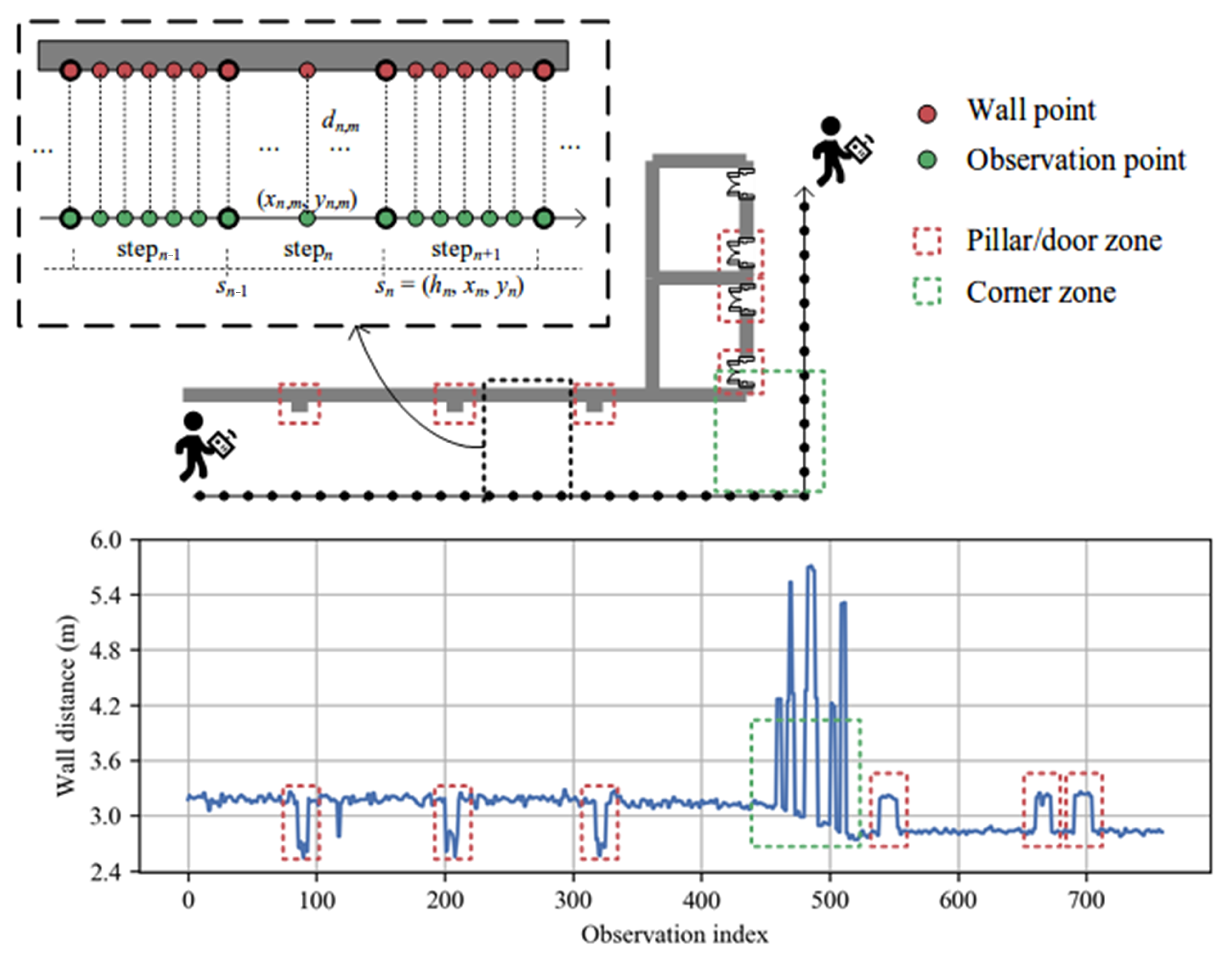

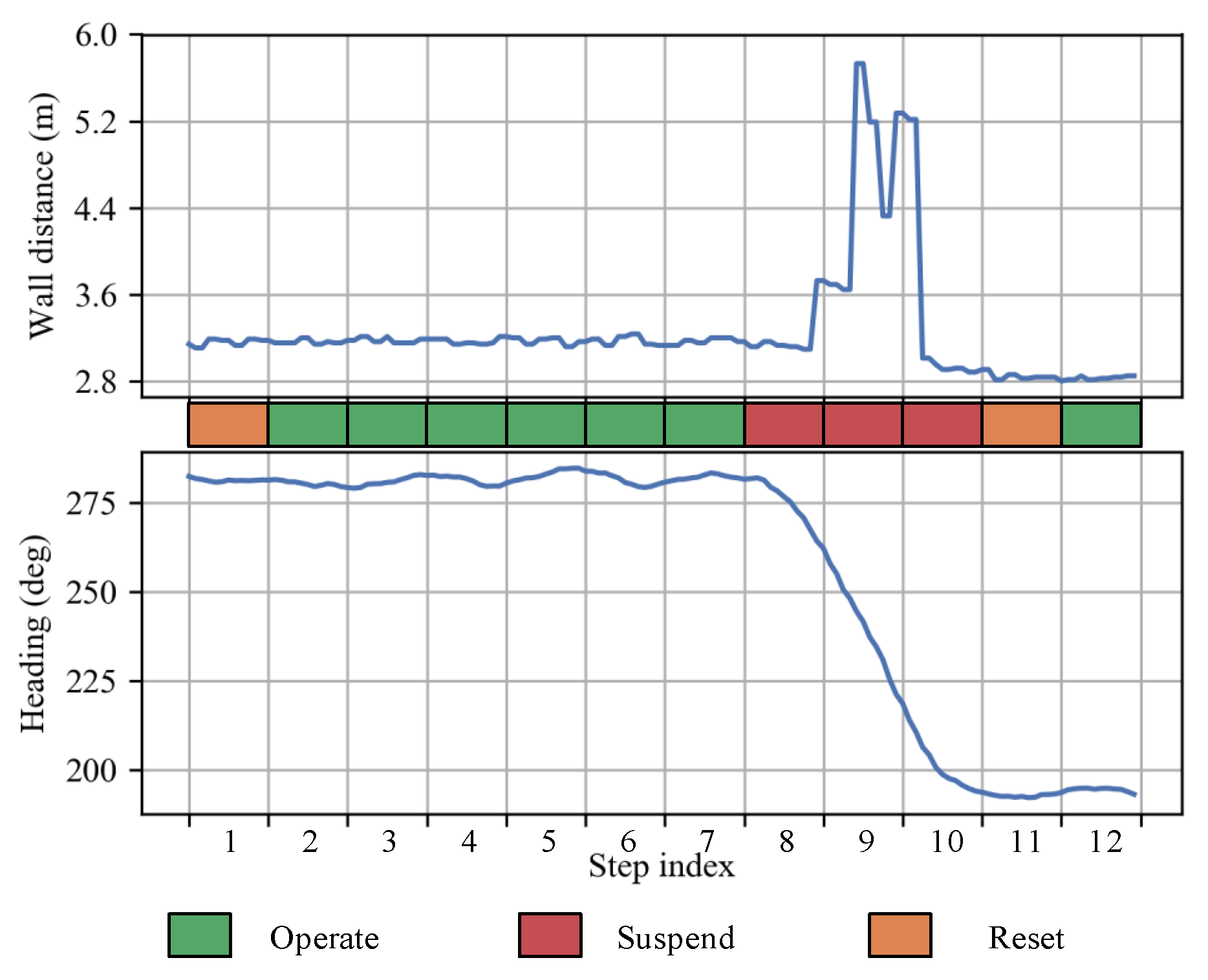

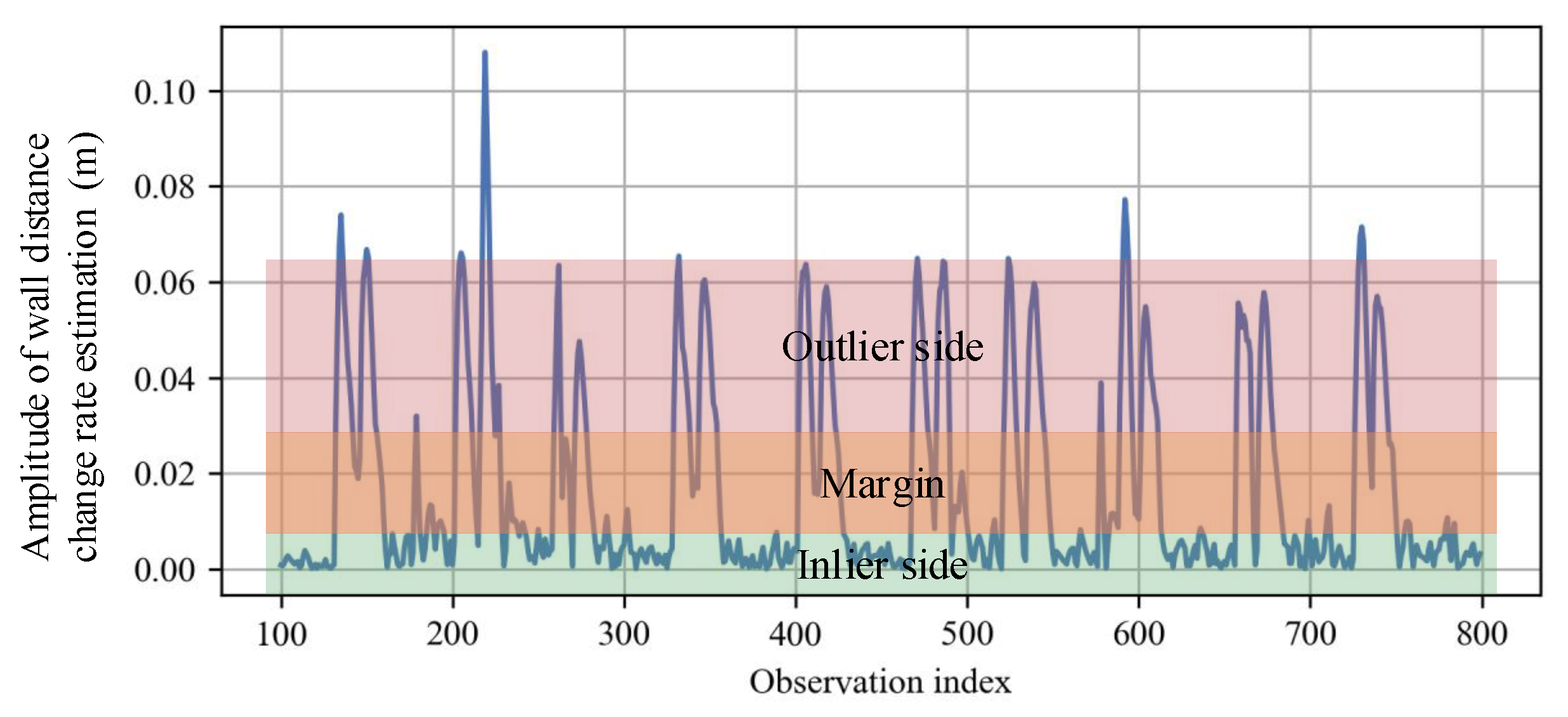

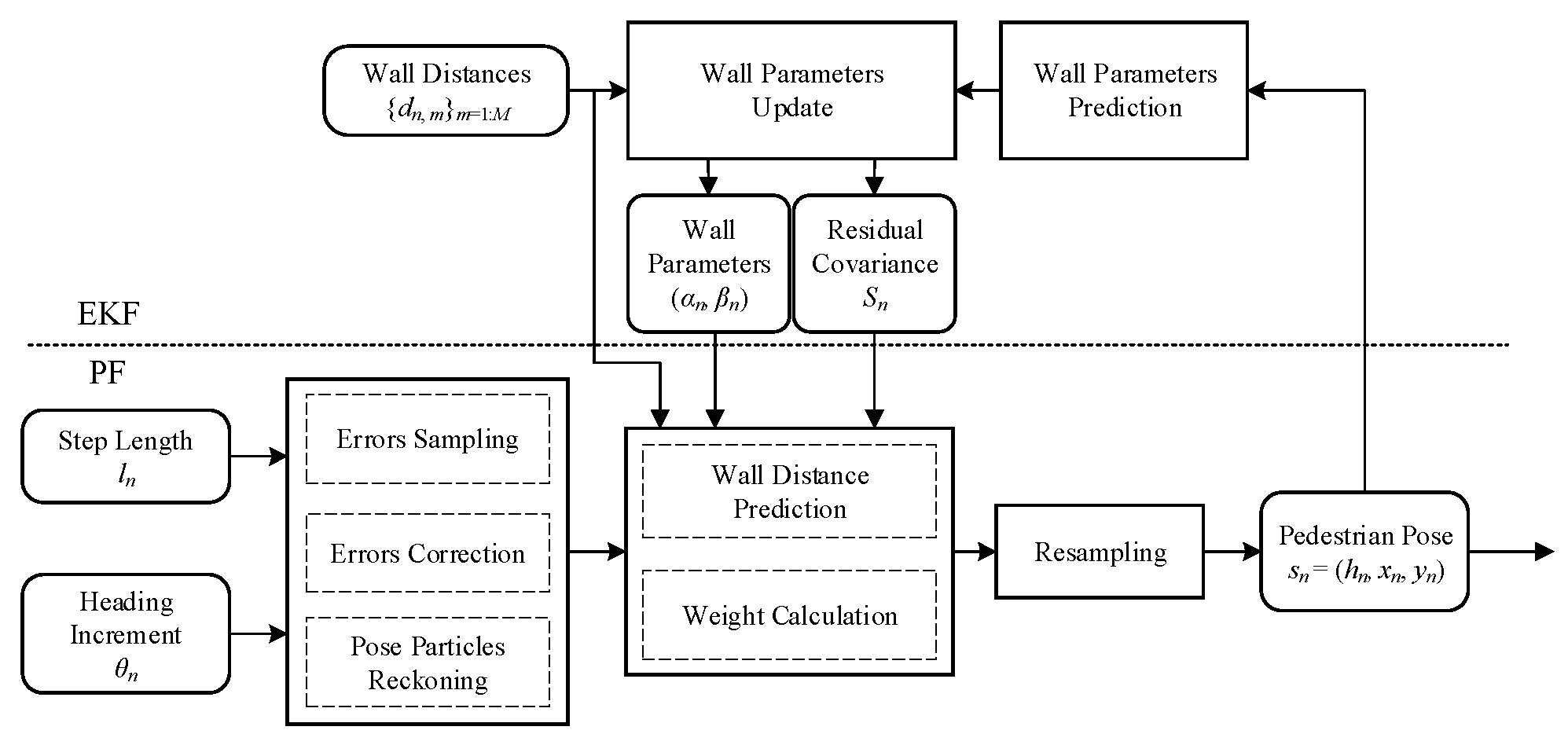
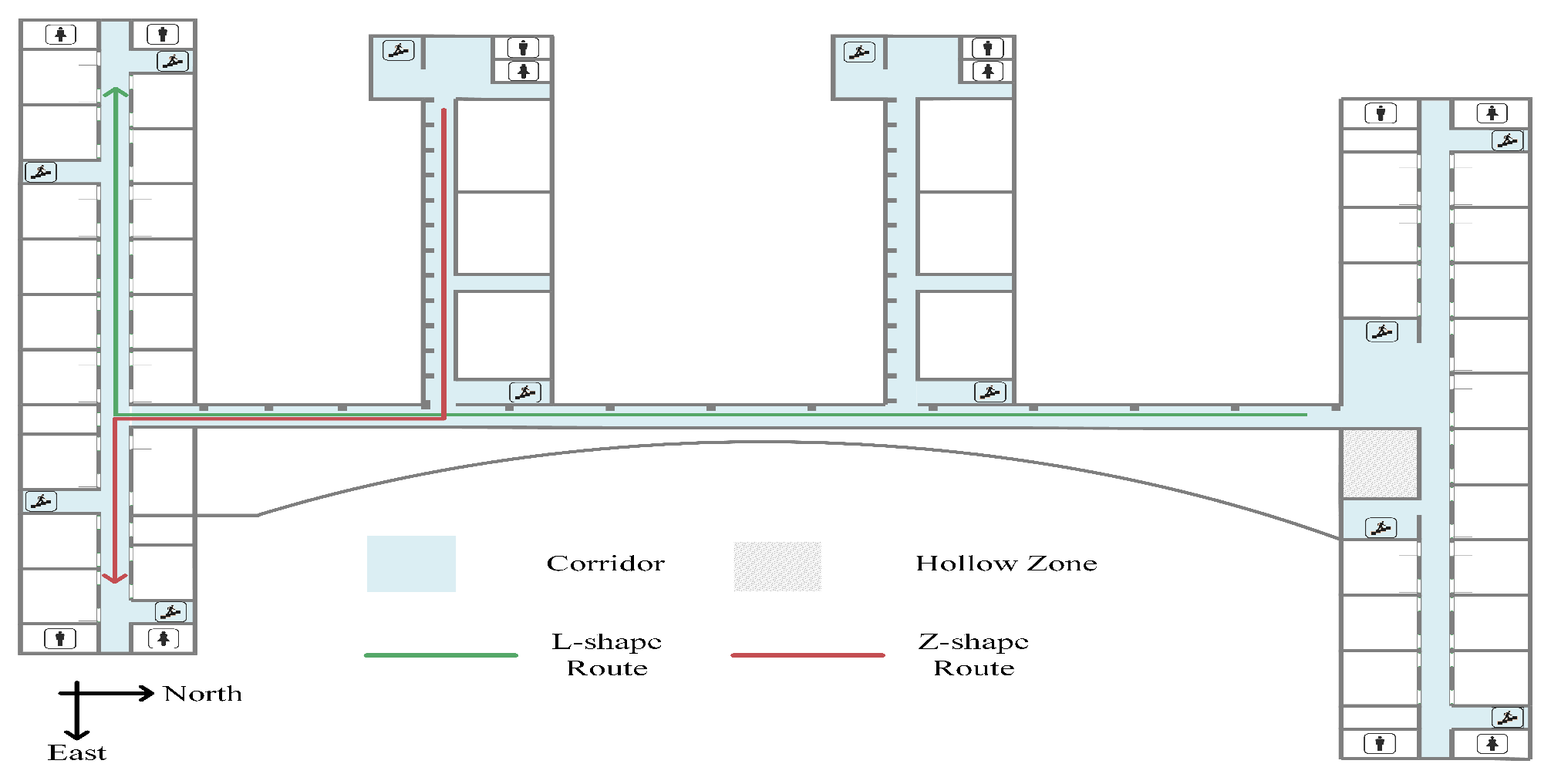

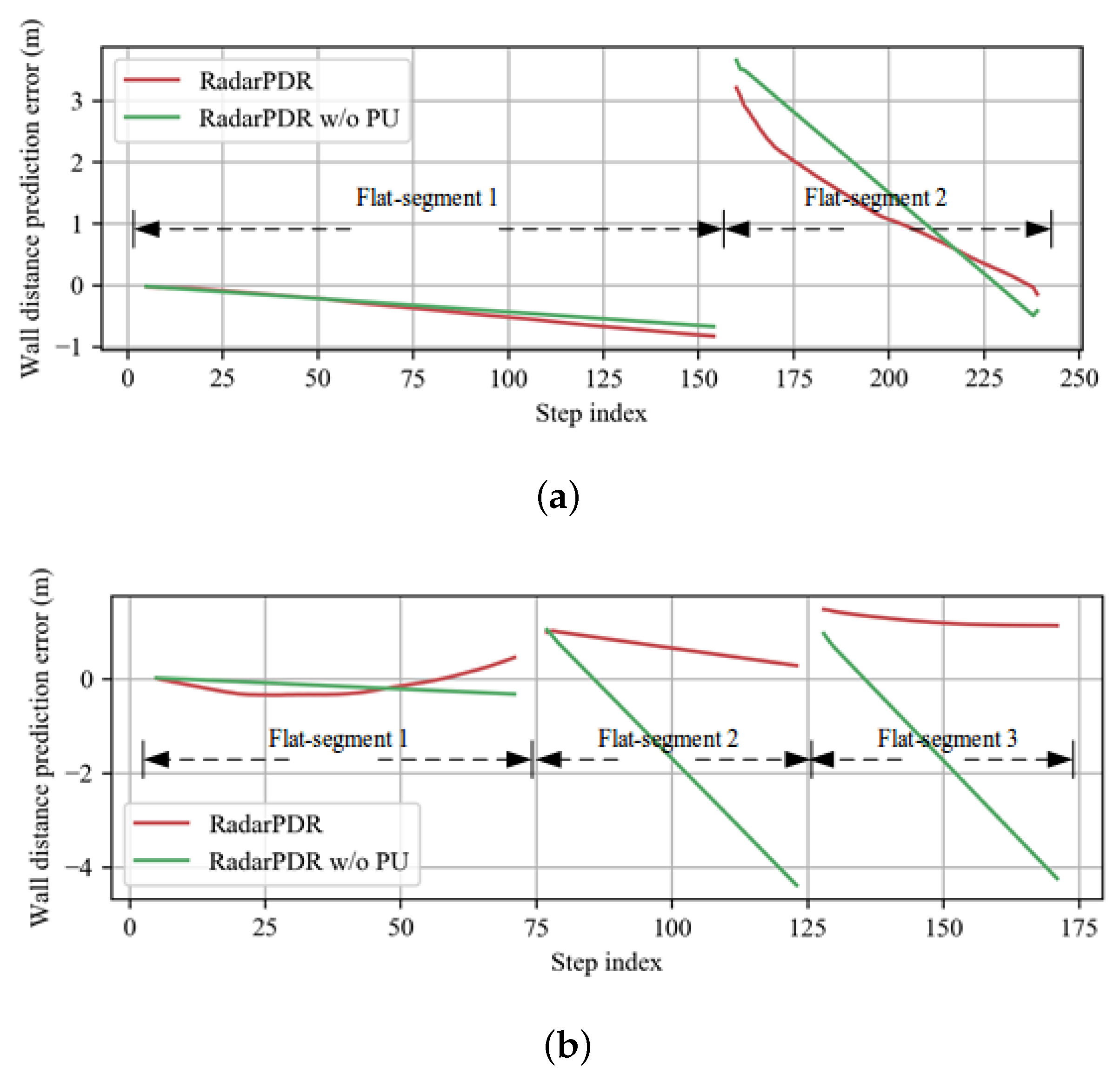

Disclaimer/Publisher’s Note: The statements, opinions and data contained in all publications are solely those of the individual author(s) and contributor(s) and not of MDPI and/or the editor(s). MDPI and/or the editor(s) disclaim responsibility for any injury to people or property resulting from any ideas, methods, instructions or products referred to in the content. |
© 2023 by the authors. Licensee MDPI, Basel, Switzerland. This article is an open access article distributed under the terms and conditions of the Creative Commons Attribution (CC BY) license (https://creativecommons.org/licenses/by/4.0/).
Share and Cite
He, J.; Xiang, W.; Zhang, Q.; Wang, B. RadarPDR: Radar-Assisted Indoor Pedestrian Dead Reckoning. Sensors 2023, 23, 2782. https://doi.org/10.3390/s23052782
He J, Xiang W, Zhang Q, Wang B. RadarPDR: Radar-Assisted Indoor Pedestrian Dead Reckoning. Sensors. 2023; 23(5):2782. https://doi.org/10.3390/s23052782
Chicago/Turabian StyleHe, Jianbiao, Wei Xiang, Qing Zhang, and Bang Wang. 2023. "RadarPDR: Radar-Assisted Indoor Pedestrian Dead Reckoning" Sensors 23, no. 5: 2782. https://doi.org/10.3390/s23052782
APA StyleHe, J., Xiang, W., Zhang, Q., & Wang, B. (2023). RadarPDR: Radar-Assisted Indoor Pedestrian Dead Reckoning. Sensors, 23(5), 2782. https://doi.org/10.3390/s23052782





